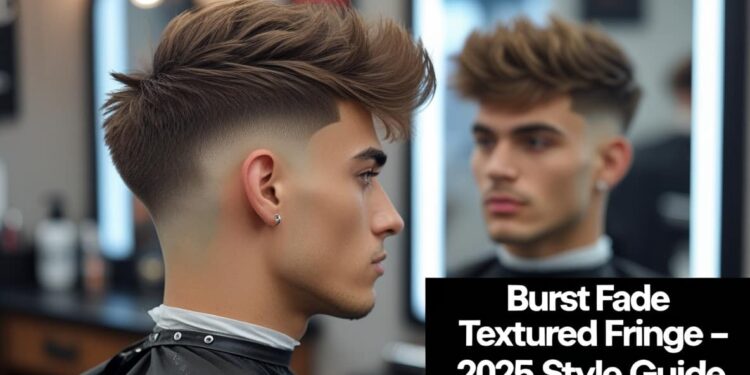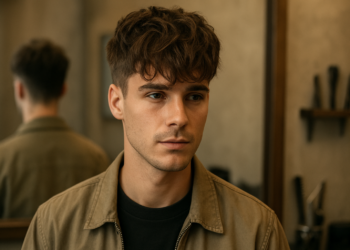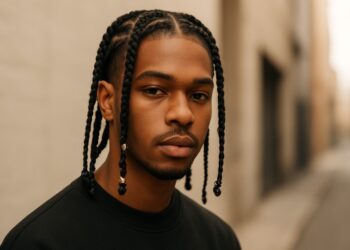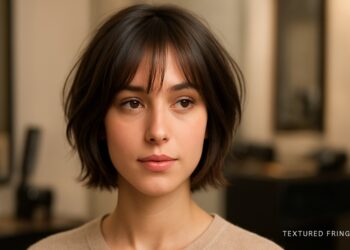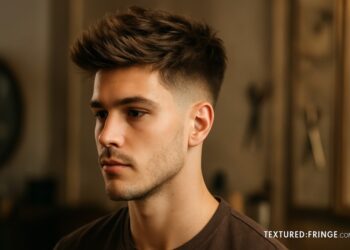The burst fade textured fringe is taking haircuts to the next level in 2025. I still remember the first time I saw this cut – a friend walked into my barber shop with hair shaved in a neat semi-circle around his ears and wispy layers falling forward over his forehead. It looked sharp, modern, and somehow easy-going at the same time. In this guide, we’ll break down everything you need to know about the burst fade textured fringe – from what it is and who it suits, to styling tips and how to ask your barber for it. Whether you’re a style-savvy consumer or a busy pro barber, this conversational (but detailed) guide covers it all – and yes, it really works on all kinds of hair.
What Is a Burst Fade Textured Fringe?
So what exactly is this haircut? A burst fade is a fade cut in a rounded, semicircle shape around each ear, tapering down toward the neck. Think of the fade “bursting” out around the ear, dropping behind it but stopping at the neckline. In practice, this means the sides are very short and curved around the ears, unlike a straight taper.
On top, a textured fringe (or textured bangs) means the front hair is cut into layers and uneven lengths to add volume, movement, and a casual flow. Instead of a blunt, straight-across bang, the hair is point-cut or layered so strands move independently and create a lived-in look.
Put them together: a burst fade textured fringe is essentially a blend of those two ideas. The sides are faded in that signature curved “burst” way, while the front/top has a choppy, tousled fringe. The result is an edgy, modern style that’s tidy around the ears but relaxed and textured on top. It’s like a mini faux hawk meets French crop, all with clean curves around the back.
The burst fade draws attention to the ears and jawline, while the textured fringe frames the face with soft layers. It’s become a mainstream staple recently, seen on red carpets and Instagram feeds alike. As one source notes, this cut “offers a modern twist on traditional fades, providing a sharp yet adaptable look” suitable for various hair types. It’s an on-trend haircut that stands out without looking overdone.
How Does It Differ from Other Styles?
To the untrained eye, a burst fade textured fringe might sound a bit like other trendy cuts. Here are the key differences:
Burst Fade vs. Taper Fade:
In a taper fade, the hair shortens gradually down to the natural hairline at the nape and temples, but the hairline stays behind the ears. In a burst fade, the fade is cut in a circular arc around each ear and actually drops behind the ear before stopping at the neck. In other words, the taper fade does not wrap under the ear (the hairline stays put), while the burst fade curves around the ear in a semicircle.
Burst Fade vs. Mullet:
Both mullets and burst fades have short sides and longer hair elsewhere, but they’re not the same. A classic mullet has longer length in back and often a sharp undercut on the sides. A burst fade has that rounded fade around the ears, giving a more gradual contrast. In a mullet you might see a straight horizontal “V” line or an undercut toward the nape, whereas a burst fade’s line is curved and circular. Stylists even combine the two into a “burst fade mullet” – but on its own, the burst fade is all about the side/ear taper, not the length at the back.
Burst Fade vs. Faux Hawk:
A faux hawk (fohawk) describes how the top is styled, not the fade shape. A faux hawk means the hair on top is left longer in the center (like a mohawk strip) and often styled upward, but the sides are generally faded or clipped shorter. By contrast, “burst fade” describes where on the sides the fade is cut. You could have a burst fade with or without a faux hawk. In practice, think of a faux hawk as the hairstyle (short sides, long middle strip) and the burst fade as the technique for fading the sides around the ears. As one barber explained, a faux hawk “features shorter sides with longer hair on top,” whereas a burst fade is specifically that semi-circular ear fade.
Who Suits a Burst Fade Textured Fringe?
The great news is: almost anyone can rock this style with small tweaks. It’s highly adaptable to different face shapes and hair textures.
Face Shapes:
Oval, square, round, and heart-shaped faces can all pull off a burst fade textured fringe. The rounded fade actually emphasizes a sharp jawline, which is great for square faces, and adding height with the fringe can balance round faces. Oval faces are almost guaranteed to look good, and heart-shaped faces benefit from the fullness at the front. The key is tailoring fringe length: for example, a long fringe can soften a square jaw, while a shorter fringe can add angles to a round face. Most barber pros will adjust the cut (fade height, fringe length) to suit your features.
Hair Types:
This cut works on straight, wavy, or curly hair. On straight hair, a burst fade helps keep things neat at the sides while you use product to create a textured fringe. Wavy hair naturally gives volume to the fringe. For curly hair, barbers often leave more length up top so the curls form a defined, bouncy fringe. In fact, stylists suggest asking for a low burst fade if you have unruly curls – this accentuates your volume while keeping the edges clean.
Thinning Hair:
Even thinning hair can benefit. A textured fringe adds the illusion of volume, and strategic layering can cover receding areas at the front. As one hair guide notes, a textured fringe can “add volume and cover thinner spots” when done right. (Just use light layering and avoid heavy gels that weigh hair down.)
Bottom line: if you’re into an edgy look but have concerns about your face or hair, this style is flexible. Your barber can tweak the fade height or fringe to flatter your shape and texture.
Styling & Maintenance Tips
Once you’ve got the cut, the right routine will keep it looking sharp. Here are my top tips (some pro secrets included):
Wash Smart:
Avoid over-washing. Shoot for 2–3 shampoos per week using a gentle, sulfate-free shampoo and conditioner. This keeps your hair clean without stripping natural oils.
Product Power:
A burst fade textured fringe looks best with the right products. Sea salt spray is a favorite – spray it on damp hair to add natural-looking grip and volume. After that, matte clay or styling wax is key. Rub a small amount between your palms and work it into the fringe and top, defining the layers and holding them without any greasy shine. (Matte clay or light wax gives a flexible hold that keeps the hair’s movement intact.)
Blow-Dry for Volume:
To really make the fringe pop, blow-dry with intention. Towel-dry hair until just damp. Then, using your fingers or a round brush, blow-dry the fringe upward and slightly forward at the roots. Tilt your head down or forward a bit while drying to encourage lift. This builds volume at the front and sets the shape. For wavy or curly hair, you can diffuse dry to let natural texture shine, then apply a bit of pomade or curl cream to define the strands without crunch.
Lighten Up:
Remember, less is more with textured hair. It’s tempting to pile on product, but a small amount usually suffices. In fact, professionals recommend using less product than you think so the fringe remains airy. Heavy gels or pomades can flatten the look (and feel stiff).
Regular Trims:
Plan to visit the barber every 3–4 weeks to keep the fade crisp and the fringe at the right length. If you let too much time pass, the burst fade will start blending out and the fringe can grow unruly. If you’re keen on a slightly grown-out look, you might stretch it to 4–5 weeks, but beyond that the intended shape starts to fade away.
Healthy Hair Routine:
A smooth, moisturized fringe is easier to style. Consider a light leave-in conditioner or curl cream if your hair is dry or curly. Also, if you notice your fringe getting oily quickly (a common issue with bangs), a quick spritz of dry shampoo on the roots can refresh it without washing.
Styling a burst fade textured fringe should be low-fuss. You’re aiming for that “undone” cool look, so don’t stress if it’s not perfect. In practice, a touch of sea salt spray, blow-dryer, and some clay usually does the trick for most guys.
How to Ask Your Barber
Getting this cut right comes down to clear communication. Here’s what to say (and show) at the barbershop:
Use the Right Words:
Clearly say “I want a burst fade,” specifying if you want it very tight (skin fade), mid, or low. Point out that you want the fade to curve around the ears rather than straight down. For the top, ask for a textured fringe or fringe “with some choppiness” – that tells the barber you want layers and movement up front.
Be Specific on Details:
Tell them exactly how long to leave the top or fringe. For example, “fringe about eyebrow length” or “covering the forehead lightly”. If you have an exact idea (say, “just above my eyebrows” vs. “mid-forehead”), say so. Mention how you want the ends – point-cut (a jagged textured end) or a straight cut.
Bring Photos:
A picture is worth a thousand words. Bring a few clear photos of the style you like: at least one from the front and one side view. Images of burst fade textured fringes are plentiful on Instagram or Pinterest, so pick ones that match your hair type (straight, curly, etc.) and desired length.
Discuss the Details:
Feel free to use simple terms: “choppy fringe,” “messy top,” or “point-cut ends.” Let them know if you want a dramatic contrast or something more subtle. (For example, “keep the sides skin-faded up to here” – pointing – and “leave that much length on top.”)
Ask for Their Advice:
Good barbers will help tailor the cut to your face and lifestyle. If you’re unsure about fade height or fringe length, ask: “Does this suit my face shape?” or “What length will be easiest for me to style daily?” A pro can suggest small tweaks (like moving the fade up or down) to make it flatter you.
Bottom line: clear communication is key. Say “burst fade” and how high, say “textured fringe” and how long. Show pics. Use a photo app on your phone if needed. That way you and your barber are on the same page and you’ll walk out with exactly the cut you envisioned.
Visual Styling Variations
The burst fade textured fringe can be customized in lots of ways to fit your vibe. Here are some popular variations:
Hair Texture – Curly vs. Straight:
If you have curly or wavy hair, the burst fade adds a nice frame. You can leave plenty of length on top so the natural curls form a defined front fringe, using curl-enhancing products to hold shape. Barbers often suggest a low burst fade for curls so the full volume stays up front. For straight (or slightly wavy) hair, the fringe is usually point-cut into jagged layers. This gives a messy, lived-in texture that you can sweep or tousle. Some men opt to sweep their longer fringe to the side for a clean, diagonal look.
Fringe Length – Long vs. Short:
You can wear a long fringe that drapes over the forehead or a short fringe that just peeks above the brows. A longer, brow-grazing fringe looks more relaxed and can be pushed to one side or allowed to fall naturally. This style is great for oval or oblong faces (it even helps “shorten” a longer face by adding a horizontal line). A very short, choppy fringe creates a sharper, more punk-inspired look – it’s edgy and easy to maintain.
Fringe Style – Side-Swept or Textured:
You might choose to style your fringe straight forward, textured and spiky, or brushed sideways. A side-swept fringe adds a touch of class and asymmetry, flattering square and heart-shaped faces. On the flip side, a forward-swept or broken fringe (strands in the middle of the forehead) amps up the modern “fauxhawk” feel.
Additional Touches:
Some go bold by adding shaved designs or hard lines in the burst fade area for extra flair. Others might incorporate a distinct hard part (a shaved line) on one side. These extras aren’t necessary but can personalize the look.
No matter your variation, the core is the same: the sides are tight and rounded, and the top has real texture. You can adjust length and styling to keep it fresh. For example, straight hair lacking movement often “needs layers” – cutting the fringe in uneven lengths adds life, as the burst fade’s contrast highlights the texture. With every tweak, this style remains modern and versatile.
Pop Culture & Trends
The burst fade didn’t come out of nowhere – it’s riding a big trend wave. Celebrities and influencers across the board have adopted it. In 2025, it’s not uncommon to see actors, models, and athletes rocking this cut on red carpets and in social media. For example, style blogs note that the burst fade has “quickly risen from barbershop buzz to a mainstream staple” and is frequently spotted on trendsetters.
It also ties into the resurgence of retro styles like the mullet and mohawk, but in a more polished way. The burst fade is essentially a punk or street style updated for everyday life. Even pop stars and fashion icons have been seen with faux hawk-like fringes (Pink and Miley Cyrus famously sported stylish faux hawks), showing this isn’t a fringe idea but a broadly appealing vibe.
What’s cool is that social media and TikTok hair tutorials have embraced it. Barbers are sharing quick videos on how to achieve “mid-burst fades” or “burst fade textured fringe tutorials,” making it one of 2025’s hottest men’s haircut trends. In essence, this style is both trendy and timeless: bold enough for creative jobs or nights out, yet neat enough for the office (especially with a subtle low or mid fade). It bridges edgy streetwear and business casual in an easy way.
FAQs
What exactly is a burst fade textured fringe?
A burst fade textured fringe combines a fade cut in a semicircular “burst” shape around the ears with a choppy, layered fringe on top. Imagine the sides shaved close in a curved line and the front hair cut into uneven layers for volume and movement. This gives a sharp contrast: clean, tight sides and a tousled bang up front.
Who can get a burst fade textured fringe?
Nearly anyone! It’s very adaptable. It flatters oval, square, round, and heart-shaped faces by adding height or balance. Straight, wavy, and curly hair all look good with this style. Even thinning hair can benefit, since the textured fringe adds the appearance of fullness in the front. Your barber can always tweak fade height or fringe length to best suit your features.
How do I ask my barber for this cut?
Be clear and use a photo. Say “I want a burst fade around the ears” and specify if you want it skin, mid, or low. Then say “a textured fringe on top” and describe the length (like “eyebrow-length fringe”). Show a picture too. Mention if you want it messy or neat. Using terms like “choppy bangs,” “point-cut ends,” or “natural texture” helps. The more precise you are, the closer the cut will match what you want.
How do I style and maintain it?
Keep it simple. Wash 2–3 times a week with a gentle shampoo. On styling day, towel-dry and work a sea salt spray through your damp hair for lift. Blow-dry the fringe up and forward to add volume at the roots, then use a matte wax or clay to define the layers. Less is more – a little product goes a long way. Trim the fade and fringe every 3–4 weeks to keep the shape crisp. Avoid heavy gels that flatten the texture.
Is a burst fade textured fringe hard to maintain?
Not really. In fact, many people say this cut is surprisingly low-maintenance. Once it’s cut right, it just needs a quick tousle each morning. Keep up regular trims (every month), and maintain your grooming routine, and it will continue to look sharp without daily fuss. A bit of styling product and a blow-dry is usually enough to get the look.
How is this different from a mullet or faux hawk?
A burst fade is not the same as a mullet or faux hawk. A mullet is mostly about long back hair with short sides; a faux hawk is about the top being mohawk-shaped. The burst fade specifically refers to the curved fade around the ears. Unlike a mullet’s sharp undercut, a burst fade has a rounded temple area. And while a faux hawk cuts the sides shorter and leaves a long strip on top, you could actually combine that with a burst fade. They can overlap, but one describes fade placement (burst) and the other top styling (fohawk).
